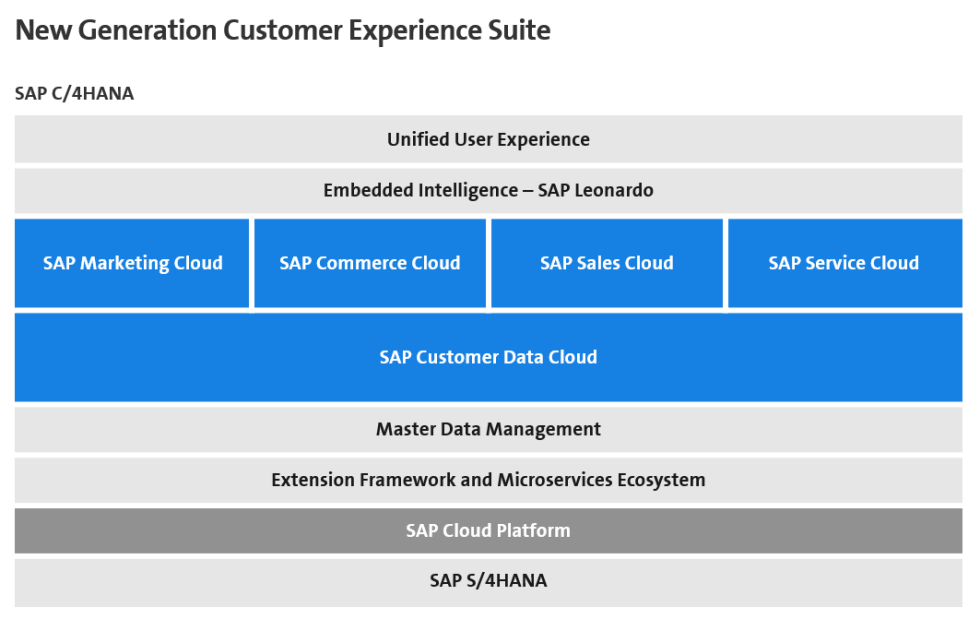Expert interview with Sascha Dengler
“Complexity is out, CX and value are in”
S for simplicity, C for customer. The existing SAP R3 and SAP ECC systems are complex. The 4HANA world with its powerful duo S/4HANA and C/4HANA is standardised, cloud based and in real time. 4HANA simplifies processes and IT landscapes because everything is located in a single closed system with real-time data.
Text and Interview: Brunhilde Mauthe,
Let’s start with a simple question: What are the benefits of moving to SAP S/4HANA and C/4HANA?
Behind the new S/4HANA and C/4HANA lies a customer experience for inventory and product management that has been improved by different worlds. This is why people are already talking about “SAP CX”, CX as in customer experience.
S4/HANA and C/4HANA are standardised and are a stark contrast to the highly customised ERP with SAP R3 and SAP ECC. What’s more, this kind of migration constitutes a major project. So why should companies make the move now?
Customisation is standard with 4HANA, which is what makes the combined power of S4 and C4 so impressive. For individual customisations, companies or SAP service providers can program extensions (similar to an app), in which the required individualised features, known as User Stories, are stored. This means for example, regardless of whether or not I need our logo for the new marketing campaign or for the newsletter from media asset management, the system accesses the extension of media asset management User Story “Get image” without integration and without altering the code. With S/4HANA, the extension makes the User Story “Get image” a standard process by means of a trigger or a time-based workflow. This differs from the “old” ERPs, where the User Story “I need our logo” required two different interfaces for the campaign and the newsletter.
For SAP service providers such as Swisscom, this is twice as interesting: we can reuse apps (Kyma Services) once created for other customers or implement joint developments for several customers. Intellectual property usually remains with the programmer and will become one of the most important business areas of cloud IT in the future, which means it is also relevant for C/4HANA and S/4HANA service providers.
You mentioned C/4HANA – what does this involve?
In 2013, SAP decided to ramp up its entry into other business areas in addition to ERP. This is where the C4/HANA world originated from. According to well-known analysts, this new cloud world is three to four times larger in terms of market volume than the market volume of S/4HANA.
The “C” stands for customer. SAP C/4HANA is a smart CRM 2.0 platform consisting of five interconnected cloud-based marketing and CRM applications: Marketing Cloud, Commerce Cloud, Customer Cloud, Sales Cloud and Service Cloud. The main difference compared to conventional CRM platforms is that it focuses not only on the sales process, but also on the customer. Which brings us back to CX, the customer experience. Users have access to all systems and therefore to all data at all times and in real time, enabling them to react much faster and with greater agility on the market.
C/4HANA Customer Clouds
Customer Data Cloud: Location of the customer login (with GDPR consensus) and customer profile creation
> Factsheet (PDF)
Service Cloud: Ticketing system, spare parts, service engineers in the field
Sales Cloud: CRM with all the information that is stored about the customer
Commerce Cloud: Web and e-shop, commerce
Marketing Cloud: Customer segmentation and classification (gold or platinum customer, voucher or cashback, etc.)
“Users have access to all systems and therefore to all data at all times and in real time.”
Sascha Dengler, Management Consultant SAP CX
And how do these two systems interact?
They are both standardised cloud systems: S4 with ERP and C4 with the five interconnected customer clouds: Marketing, Commerce, Customer, Sales and Service. The Cloud Integration Platform connects the systems with each other as well as with third-party systems that are already in use. This means that the standardised and integrated interfaces between S4 and C4 already exist and are simply enhanced with User Exits (SAP standard enhancements). In addition, the extension framework SAP Kyma (apps) offers simple and fast solutions for further connections between the systems and third-party systems.

When and how should a customer migrate to the 4HANA world?
1 When? Technically, before 2027 at the latest, because from then on SAP ECC and R/3 will no longer be supported. But from the customer’s point of view, it’s better to have done it yesterday.
How? The customer has several options. First migrate to S/4HANA and then address the C/4 issues. But the opposite way round can also be the right approach. This all depends on the strategy. For C/4, there is a Movement program which includes three scenarios.
- Everything that was previously active in ECC or R/3 is activated in S/4. This is the “safeguard version”.
- When new components from the C/4 cloud are added, we refer to this as the “hybrid version”.
- If the service and sales functions are transferred completely to C/4, this is known as the “digitisation version”. In this case, it makes sense to first transfer and then start the S/4HANA project.
Benefits of S/4HANA and C/4HANA
- Cloud based
- Automatic updates
- Low maintenance
- Low complexity
- Improved customer service
- Faster go-to-market
- More out-of-the-box integration for the customer’s system landscape and applications
- Focus on customer value
- The business implements projects faster, IT is no longer a bottleneck
“The transition to the 4HANA world is individually designed.”
Sascha Dengler, Management Consultant SAP CX
Which companies in Switzerland have already moved to S/4HANA?
Ricola and the SV Group have moved to S/4 together with Swisscom. Many other customers have started the transition to the S/4 portfolio and there are now almost 50 customers in the Discover and Prepare workshops. Many customers also test the C/4 components in this context.
And Swisscom?
As part of Simplicity, we will also move to S/4HANA and take a closer look at some of the C/4HANA variants. In addition to CRM, we are also looking at the area of direct customer feedback so that we can better analyse O-data (operational data) and X-data (incremental customer feedback). We are also evaluating our approach, just like our customers.
A final word?
We are currently living in a radical world of transition. S4 and C4 help to simplify processes, system landscapes and customer orientation by placing everything in a single closed system and making data available in real time. All data have their specific and assigned location in the systems. The 4HANA environment forms a stable structure with state-of-the-art architecture, where all processes are combined in an intelligent suite.
And what’s more, with the 4HANA world SAP is concentrating on its strengths, specifically on end-to-end scenarios for the customer: Lead-to-Cash, Recruit-to-Retire (HR), Design-to-Operate (Supply Chain) and Source-to-Pay (Spend Management) based on S/4HANA as the digital core. At the same time, these solutions are offered in different environments, whether hosting in the Swisscom environment or on the multi-clouds (Azure, Google or AWS). This means SAP is returning to its core competencies and better integrating the ecosystems. Everybody concentrates on the things they do best; for us this is the operation and implementation of systems as well as the integration of the third-party extension and further developments.
About Sascha Dengler
SAP specialist Sascha Dengler is an engineer and certified in C/4HANA (Marketing, Commerce, Sales, Service and customer data).

An experienced Management Consultant, at Swisscom he is responsible for the analysis, design, implementation and support of SAP C/4HANA applications as well as SAP strategy and consulting. His core competencies are in the areas of customer experience, sales channels, customer and product data as well as their integration into the customer architecture. He has implemented numerous digital transformation and end-to-end integration projects.
More on the topic


